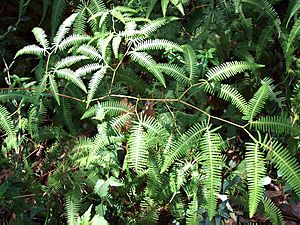Gleichenella facts for kids
Quick facts for kids Gleichenella |
|
|---|---|
 |
|
| Scientific classification | |
| Genus: |
Gleichenella
|
| Species: |
pectinata
|
| Synonyms | |
|
|
Gleichenella is a small group of ferns. It belongs to the plant family called Gleicheniaceae. There is only one main type of fern described in this group, which is named Gleichenella pectinata.
These ferns are often found in warm, wet places. They grow in tropical and subtropical regions around the world. You might see them in forests or along roadsides.
Contents
About Gleichenella Ferns
Gleichenella pectinata is a unique fern. It is known for its interesting leaf structure. Like all ferns, it does not produce flowers or seeds. Instead, it reproduces using tiny spores.
Where They Grow
Gleichenella pectinata prefers humid environments. It thrives in areas with plenty of moisture. This includes rainforests and cloud forests. It can often be found growing on the forest floor. Sometimes it climbs over other plants or rocks.
These ferns are common in parts of Central and South America. They also grow in some Caribbean islands. Their ability to spread helps them cover large areas.
What They Look Like
The leaves of Gleichenella pectinata are quite special. They are often described as "pectinate." This means they look like a comb. The leaflets are arranged neatly along the main stem.
The fronds (fern leaves) can grow quite long. They often branch out in a unique way. This creates a tangled, bushy appearance. The stems are usually wiry and strong.
Young fronds often have a reddish or brownish color. As they grow, they turn a vibrant green. The underside of the leaves holds the spores. These are in small, round structures called sori.
How Ferns Reproduce
Ferns have a fascinating way of reproducing. They do not use flowers or seeds like many plants. Instead, they use spores. Spores are tiny, dust-like particles.
The life cycle of a fern has two main stages. One stage is the fern plant we see. This plant produces spores. These spores are released into the air. If a spore lands in a good spot, it grows.
The spore grows into a small, heart-shaped plant. This tiny plant is called a gametophyte. The gametophyte produces reproductive cells. These cells then join together. This forms a new fern plant. This new plant will grow into the large fern we recognize.
Importance of Ferns
Ferns like Gleichenella pectinata are important. They help keep ecosystems healthy. They provide shelter for small animals. They also help prevent soil erosion. This is especially true on slopes.
Ferns add to the beauty of natural landscapes. They are a key part of forest environments. Studying them helps scientists understand plant evolution. It also helps us learn about biodiversity.
See also
 In Spanish: Gleichenella para niños
In Spanish: Gleichenella para niños

